Rolfing, a form of Structural Integration, continues to gain prominence for its ability to alleviate chronic pain, enhance mobility, and support injury recovery. One of its most fascinating applications lies in addressing scar tissue and its impact on the body. But how does Rolfing achieve this, and why is it effective in rehabilitating injuries?
What Is Scar Tissue?
Scar tissue forms as a natural part of the body’s healing process following an injury, surgery, or significant trauma. It consists of collagen fibers that are placed rapidly and often in a disorganized manner. While this is necessary for wound closure, the resulting tissue can be denser and less flexible than the original. Over time, untreated scar tissue can restrict movement, impede circulation, and contribute to chronic pain.
The Role of Rolfing
Rolfing is a specialized form of bodywork that focuses on reorganizing the body’s fascia—the connective tissue that surrounds and supports muscles, organs, and other structures. Through hands-on manipulation, the Rolfing therapist releases tension patterns, improves alignment, and restores natural movement. When it comes to scar tissue, Rolfing can:
- Break Up Adhesions: Scar tissue often binds to surrounding tissues, forming adhesions that restrict movement. Rolfing employs targeted pressure and movement to gently break these adhesions, increasing mobility and reducing discomfort.
- Restore Fascial Health: By working on the fascia around the scar, Rolfing helps to reorganize the collagen fibers, making the tissue more pliable and functional.
- Improve Circulation and Lymphatic Flow: Manipulating the tissue can enhance blood flow and lymphatic drainage in the area, promoting healing and reducing inflammation.
How Rolfing Supports Injury Rehabilitation
Injuries often lead to compensatory movement patterns as the body adapts to avoid pain. These adaptations can persist long after the injury has healed, creating imbalances and further strain on other areas of the body. Rolfing addresses these issues by:
- Realigning the Body: Rolfers work to restore the body’s natural alignment, reducing stress on joints and muscles.
- Releasing Chronic Tension: Injuries often lead to protective muscle guarding, which can become habitual. Rolfing helps to release this tension, allowing for more efficient movement.
- Enhancing Body Awareness: Rolfing sessions often include education on posture and movement, empowering clients to prevent future injuries.
Is Rolfing Right for You?
If you are struggling with pain, stiffness, or limited mobility due to scar tissue or past injuries, Rolfing may offer significant relief. As with any form of bodywork, it is essential to consult with a qualified practitioner and discuss your specific needs and medical history.
By addressing scar tissue and supporting the body’s natural healing processes, Rolfing provides a unique pathway to recovery. This therapy aids in rehabilitation by gently manipulating the body’s fascia, effectively releasing restrictions and adhesions left by scarring. As a result, Rolfing can improve mobility, reduce pain, and promote better overall body alignment, particularly in areas affected by injury or surgery. Essentially, it helps the body reintegrate the scarred tissue and restore functionality.
Take the First Step
Ready to experience the benefits of Rolfing? If you live or work in Southern California, consult with Bob Alonzi, a Certified Advanced Rolfer. Visit Bob Alonzi’s website or call 310-451-3250 to schedule an appointment.


Recent Comments